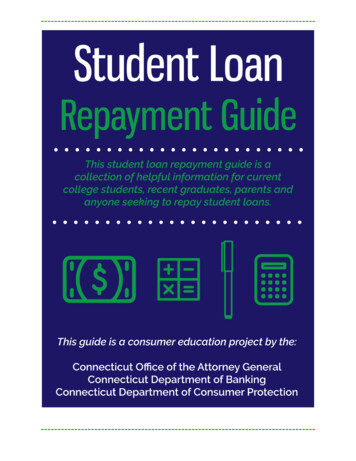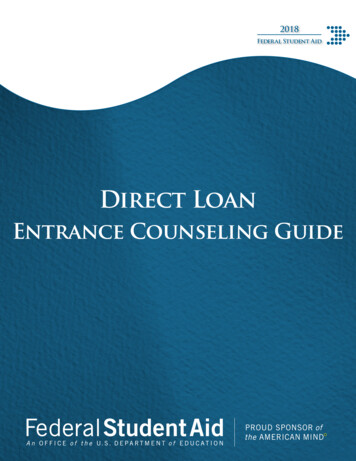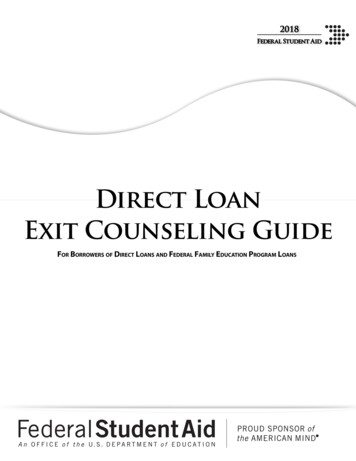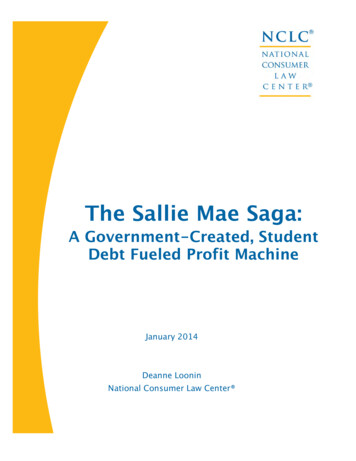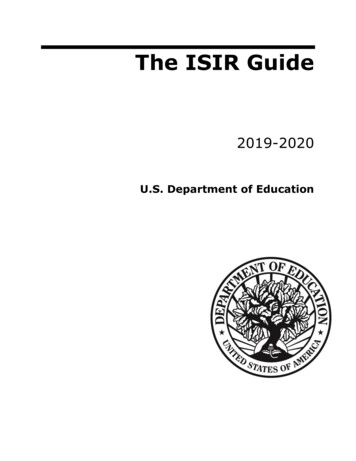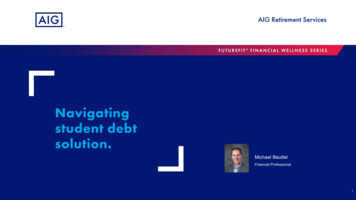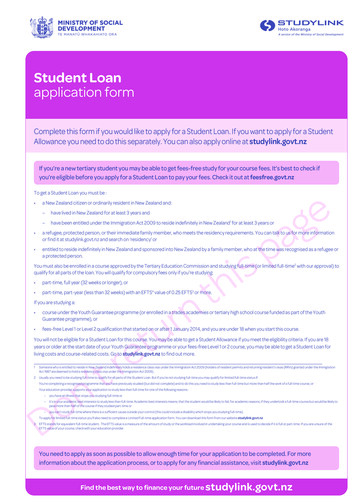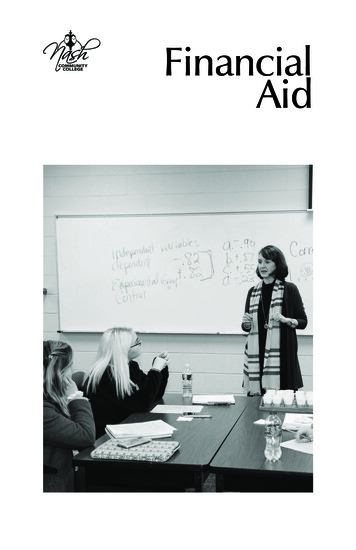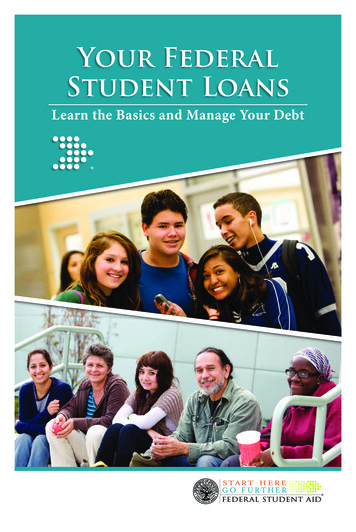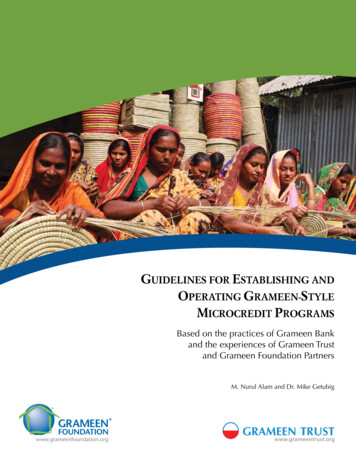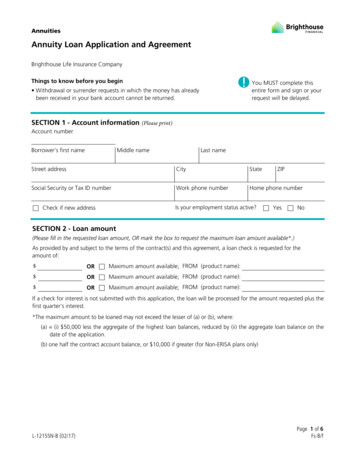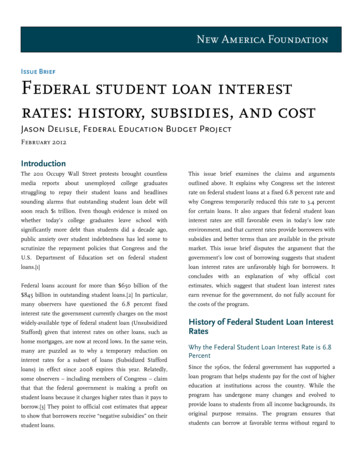
Transcription
New America FoundationIssue BriefFederal student loan interestrates: history, subsidies, and costJason Delisle, Federal Education Budget ProjectFebruary 2012IntroductionThe 2011 Occupy Wall Street protests brought countlessThis issue brief examines the claims and argumentsmediagraduatesoutlined above. It explains why Congress set the intereststruggling to repay their student loans and headlinesrate on federal student loans at a fixed 6.8 percent rate andsounding alarms that outstanding student loan debt willwhy Congress temporarily reduced this rate to 3.4 percentsoon reach 1 trillion. Even though evidence is mixed onfor certain loans. It also argues that federal student loanwhether today’s college graduates leave school withinterest rates are still favorable even in today’s low ratesignificantly more debt than students did a decade ago,environment, and that current rates provide borrowers withpublic anxiety over student indebtedness has led some tosubsidies and better terms than are available in the privatescrutinize the repayment policies that Congress and themarket. This issue brief disputes the argument that theU.S. Department of Education set on federal studentgovernment’s low cost of borrowing suggests that studentloans.[1]loan interest rates are unfavorably high for borrowers. Itreportsaboutunemployedcollegeconcludes with an explanation of why official costFederal loans account for more than 650 billion of theestimates, which suggest that student loan interest rates 845 billion in outstanding student loans.[2] In particular,earn revenue for the government, do not fully account formany observers have questioned the 6.8 percent fixedthe costs of the program.interest rate the government currently charges on the mostwidely-available type of federal student loan (UnsubsidizedStafford) given that interest rates on other loans, such ashome mortgages, are now at record lows. In the same vein,many are puzzled as to why a temporary reduction oninterest rates for a subset of loans (Subsidized StaffordHistory of Federal Student Loan InterestRatesWhy the Federal Student Loan Interest Rate is 6.8Percentloans) in effect since 2008 expires this year. Relatedly,Since the 1960s, the federal government has supported asome observers – including members of Congress – claimloan program that helps students pay for the cost of higherthat that the federal government is making a profit oneducation at institutions across the country. While thestudent loans because it charges higher rates than it pays toprogram has undergone many changes and evolved toborrow.[3] They point to official cost estimates that appearprovide loans to students from all income backgrounds, itsto show that borrowers receive “negative subsidies” on theiroriginal purpose remains. The program ensures thatstudent loans.students can borrow at favorable terms without regard to
their credit histories, incomes, assets, or fields of study.[4]pending interest rate change for both borrowers andIn 2011, students borrowed over 100 billion in federallenders enacted in 1993 was still set to occur in 1998. As aloans and over 650 billion in federal student loans wereresult, lenders in the bank-based program – whomoutstanding.[5]Congress assumed in 1993 wouldn’t be playing the majorrole they still were in 1998 – expressed concerns that theFrom the program’s inception until 1992, Congress set theinterest rate change would increase their costs and reduceinterest rate on student loans at fixed rates ranging fromreturns to such an extent that they would no longer be6.0 percent for loans issued in the 1960s to 10.0 percent forwilling to make federally-backed student loans.[11]loans issued between 1988 and 1992.[6] Congress enactedvariable rates in 1992 seeking to better align them with theFearing that lenders would flee the program and disruptinterest rate the government paid private lenders holdingloan availability, in 1998 Congress postponed the pendingthe loans, thereby reducing the government’s costs.[7] Therate changes until 2003 (a permanent fix was too costly)new variable rates reset once a year based on the interestand left the then-current interest rate formulas in placerates on short-term U.S. Treasury securities plus 3.1with some minor adjustments (it reduced the markup onpercentage points (a “markup”), capped at 9.0 percent.the borrower’s annual interest rate from 3.1 to 2.3Congress made minor adjustments to this formula over thepercentagesubsequent six years, lowering the markup and the cap.participating in the bank-based loan program continued topoints).Despitethisaction,lendersexpress worries over the interest rate structure change, nowShortly after the move to variable rates, in 1993 Congressdelayed until 2003. They encouraged Congress to address itpassed the Student Loan Reform Act to establish the Directbefore mid-2002Loan program.[8] Congress intended this program, underavailability.to avoid disrupting student loanwhich the U.S. Department of Education makes loansdirectly to students, to gradually replace the existingAs an alternative to the pending rate change, lenders andprogram that subsidized private lenders to make loans (i.e.some lawmakers proposed making permanent the then-the bank-based program). At the time, policymakers alsocurrent formulas (short-term interest rates plus 2.3sought to more closely link the interest rates borrowerspercentage points). But student advocates and somewere charged to the rates the government paid to borrowlawmakers opposed this approach because the formula setsince there would be no further need to link them toto take effect in 2003 (variable rates based on longer-termsubsidies for private lenders.[9] In response, the 1993 lawU.S. Treasury rates plus 1.0 percentage point) producedpegged borrower rates to longer-term U.S. Treasurymore favorable rates for borrowers.[12] At the time, short-securities that were similar in duration to the student loans,term and long-term Treasury rates were similar, meaningplus a smaller markup of 1.0 percentage point would bethat the lower markup built into the pending formulacalculated for loans issued after July 1, 1998.[10] Thisproduced lower overall rates.formula would also be used to set the interest rateguaranteed to lenders for any loans still made in the bank-In late 2001, after months of negotiations, lawmakersbased program in 1998 and later.proposed a bipartisan compromise that would avert thepending rate change and make permanent the then-currentBy the mid-1990s, the Direct Loan program phase-in hadinterest rate formula for lenders. It also extended throughnot gone as Congress had originally planned; as 19982006 the existing variable rate formula for borrowers butapproached, the bank-based program still accounted for theestablished fixed interest rates at 6.8 percent for Subsidizedmajority of newly-issued federal loans. However, thenew america foundationpage 2
and Unsubsidized Stafford loans made after July 1,2006.[13]A 2005 Effort to Block Fixed Rates Sets Stage forTemporary Rate CutDespite the low interest rate environment of the mid-Lawmakers, higher education associations, and student2000s, the fixed rates scheduled to take effect in 2006advocate organizations championed the bill because thereceived little attention until 2005 when Congressfixed 6.8 percent interest rate that would start in 2006 wasconsidered proposals to reduce annual budget deficits. Thatlower than estimates of what borrowers would pay ifyear, Republican majorities in the House and Senate beganCongress had maintained the variable formula.[14] Indrafting legislation to cut spending and reduce budgetselecting a fixed rate, Congress and advocacy groupsdeficits. Both chambers made changes to federal studentdecided on 6.8 percent because it was approximately theloans a large component of their respective proposals,average of the projected interest rates set to take effect inspurred by reforms outlined in the president’s budget2003 based on longer-term U.S. Treasury bills.[15]request.Supporters also cited the certainty that fixed rates providedover variable rates as a benefit to borrowers. The SenateThe House plan would have cancelled the fixed interestpassed the bill unanimously in December 2001, the Houserates set to take effect in 2006, maintaining the existingpassed it with overwhelming support in January 2002, andvariable rate formula, which that year set rates between 3.4the president signed it into law.and 5.3 percent.[17] Sponsors of the proposal argued thatvariable rates would be better for borrowers and taxpayers.Congress chose to delay the implementation of the fixedThe Senate, however, maintained the fixed rates set to takerates until 2006 – maintaining the existing variable rateeffect in 2006.[18]formula in the meantime – to reduce the costs of the policyover a ten-year budget window. The Congressional BudgetTo meet deficit reduction goals, both the House and SenateOffice estimated that adopting fixed rates would reduce thebills made a change to the interest rate guaranteed torates for borrowers compared to then-current law,lenders making federally-backed student loans, requiringincreasing costs for the government by 5.2 billion fromthat they rebate interest borrowers paid in excess of the rate2007-2011.[16] It would have cost more if Congress hadthe government guaranteed lenders.[19] The provision cutchosen to implement the change immediately.spending compared to then-current law because it reducedwhat lenders could earn on the loans. However, the SenateMeanwhile, in the latter half of 2001, the U.S. Federalbill had the greatest deficit-reducing effect because it leftReserve was in the midst of reducing its short-termthe scheduled fixed rates in place, increasing the size of thebenchmark interest rate in response to a mild economiclender rebates. The rebate provision produced 34.4 billionrecession and the terrorist attacks of September 11th, 2001.in savings over ten years in the Senate bill compared toBy the time the ink was dry on the 2002 law that 14.5 billion under the House’s variable rate proposal.[20]established the fixed 6.8 percent interest rate, the FederalReserve had cut short-term interest rates below 2.0 percent.It had been as high as 6.5 percent in early 2001. Two moreFederal Reserve rate cuts in 2002 and 2003 brought therate to 1.25 percent and 1.0 percent, respectively. Given thelow-interest rate environment that began in 2002, itappeared unlikely that fixed 6.8 percent rates would lowercosts for borrowers as supporters had previously argued.new america foundationWhy Interest Rates on Some Loans May DoubleThis YearThe president signed a final version of the deficit reductionbill into law in January 2006, which included the Senate’sproposal to maintain the fixed rate formula and impose arebate on lenders.[21] Even though Congress enacted thepage 3
fixed rates in 2002, some observers interpreted Congress’eligible for Subsidized Stafford loans, only undergraduatedecision to maintain the rates as a Republican-led Congressstudents were eligible for the rate cut. The bill left ratescharging higher interest rates on student loans to reduceunchanged for the largest loan category – Unsubsidizedthe deficit.Stafford loans – as well as for PLUS loans for parents andgraduate students, despite their inclusion in the campaignIn their 2006 campaign platform, A New Direction forpledge. All new costs in the bill were offset with spendingAmerica, House Democrats claimed that “Congressionalreductions on subsidies for lenders making federally-Republicans have allowed student loan interest rates tobacked student loans, ensuring that the bill complied withincrease, making student loans even harder to repay.” ThePay-As-You-Go principles.platform document promised to “slash interest rates oncollege loans in half to 3.4 percent for students and to 4.25To further reduce the cost of the proposal, the bill phased inpercent for parents,” if Democrats were elected that fall.[22]incremental rate cuts starting in the 2008-09 school yearsuch that only loans issued for the 2011-12 school year wouldAfter Democrats won majority control of both the Housecarry rates of 3.4 percent (half of 6.8 percent). Subsidizedand Senate in 2006, the Congressional Budget OfficeStafford loans issued after that year would again carry aestimated that the rate cut proposal would cost 52 billionfixed rate of 6.8 percent. In short, the proposed legislationand 133 billion over five and ten years, respectively,“cut interest rates in half” for loans issued only in one year.compared to then-current policy – revealing that theproposal was extremely costly. The rate cut for PLUS loansThe changes to the original proposal – limiting the cut tofor graduate students and parents accounted for about two-Subsidized Stafford loans for undergraduates, phasing it in,thirds of the cost.and ending it in 2012 – reduced the cost to 7.1 billion inthe ten-year budget window, much less than the earlierThe high cost of the proposal did not bode well for theestimate for the permanent cut for all loan categories.Democrats’ campaign pledge because the newly electedMaking the rate cut permanent for Subsidized Staffordmajority had also pledged to follow Pay-As-You-Goloans for undergraduates after 2012 would have cost anbudgeting principles to fully offset new spending with taxadditional 12.8 billion over ten years.[24]increases or other spending cuts. The Pay-As-You-Goprinciples meant that lawmakers would have to enact 132In September of 2007, both the House and Senate passed abillion in spending cuts over ten years (a substantial sum)budget bill that included the rate cut provision, and thewithin education or other programs, or raise taxes to offsetpresident signed it into law.[25] The first rate cut went intothe new spending in the rate cut proposal. In the end,effect for Subsidized Stafford loans issued in the 2008-09lawmakers opted to scale back their original proposal toschool year. Loans issued this coming 2012-13 school yearreduce the cost.will carry a 6.8 percent interest rate because the 2007 ratecuts will have expired.Just weeks into the new session of Congress in January2007, the new House Democratic majority passed a bill tocut interest rates in half, but with significant caveats.[23]The bill cut rates in half only for a subset of loans –Subsidized Stafford loans – which are available only toborrowers from families with middle and lower incomes.While both graduate and undergraduate students had beennew america foundationpage 4
Assessing the Current 6.8 PercentInterest RateAre Federal Student Loan Interest Rates TooHigh?latter measure, current interest rates are in fact set lowenough to subsidize borrowers and impose costs on thefederal government.fixed interest rates for nearly its entire history – the periodInterest Rates on Home Mortgages and PrivateStudent Loansbetween 1992 and 2006, when Congress linked the rateIn today’s low interest rate environment, many types ofannually to short-term U.S. Treasury rates, being the onlyloans carry interest rates below the 6.8 percent fixed rateexception. Due to interest rate fluctuations in the market,Congress set on federal student loans. At first glance, thisany fixed rates that Congress sets in law are bound to becould indicate that the federal program does not provide theeither too high or too low over time. As such, in the earlylevel of assistance that many believe it should or thatdecades of the program Congress raised the fixed rates onlawmakers originally intended, possibly allowing the federalnewly issued loans to keep up with rising market interestgovernment to earn revenue on these loans. Whenrates. In today’s low interest rate environment, Congress iscompared to interest rates on private loans, however, it isunder pressure to lower the fixed rates. This pressure isclear that the interest rates on federal student loans dolikely to increase as the temporary rate cut on Subsidizedprovide a benefit and subsidy to borrowers.The federal student loan program has charged borrowersStafford loans is set to expire later this year.While many people think of the fixed rate 30-year mortgageMany people believe that the low interest rates lendersas a benchmark by which to compare other types of loans, itcurrently offer on home mortgages and other types of loansis a poor reference point for the interest rate charged onsuggest that interest rates on federal student loans are toostudent loans. Lenders are willing to provide relatively lowhigh. Some observers also argue that the current fixedfixed rates on mortgages (the rate on a 30-year fixed rateinterest rates for borrowers are far more expensive thanmortgage is approximately 4.0 percent) because losses fromwhat it costs the government to borrow, suggesting that thedefault are limited by the value of the home – which can befederal government overcharges borrowers and earnsseized and sold by the lender – and by any equity therevenue from the program. Additionally, some claim thathomeowner has in the property from a down payment,official budget estimates indicate that the rates theprice appreciation, or both, that would be forfeited in agovernment charges are high enough that it earns a “profit”default.on student loans.Federal student loans pose a higher risk of default loss thanA review of key information, however, suggests that interesta home mortgage because lenders have no asset to recoverrates on new student loans are low relative to what privatein the event of a default and borrowers with student loanslenders charge on fixed rate loans and are below what ithave no equity at risk in the transaction. Additionally,costs the government to make the loans. To be sure, ratesmortgage lenders can screen out borrowers with poor creditmay indeed be too high relative to some borrowers’ abilitieshistories and low incomes, further limiting the likelihood ofto repay or according to those who believe the federaldefault.government ought to increase subsidies for higherrequirements on borrowers as students are eligibleeducation. Those measures, however, concern the degree toregardless of their credit histories or incomes.Federalstudentloansimposenosuchwhich the federal government subsidizes student loans, notwhether the current terms offer any subsidy at all. On thenew america foundationFederal student loan interest rates are also commonlypage 5
compared with the low variable rates that lenders haveWells Fargo, for example, advertises a 9.24 percent rate foroffered in recent years on non-federal student loans.career and community college students, but offers lowerHowever, these comparisons are misleading due to therates to students attending other institutions.[29] Somenature of variable rates. Lenders offer lower initial rates onlenders advertise that borrowers with no credit histories,variable rate loans than on fixed rate loans because thelow credit scores, or low incomes could pay rates as high asborrower bears all the interest rate risk on the loan. That is,12.25 percent.[30]the borrower will have to shoulder the cost of rising interestrates, not the lender. On a fixed rate loan, in contrast, theIn comparison, federal student loans provide the samelender bears the risk that interest rates will rise andterms to all borrowers regardless of their credit histories orfinancing costs will exceed the interest it charges on a fixedother measures of their abilities to repay. The loans neverrate loan.require a co-signer or charge different interest rates basedon the type of institution a borrower attends.[31] FederalThus a lender can charge less on a variable rate loan than astudent loans also offer additional, non-interest ratefixed rate loan (at the time the loans are issued) because itbenefits that private loans do not. These include three-yeardoes not need to guard against the risk of rising interestdeferment and forbearance for economic hardship, as wellrates in the future. That means that the 3.3 percent interestas a wide range of repayment options, such as interest-onlyrate that Citibank currently charges on its variable rateand income-based plans. Any comparison of the relativeCitiAssist loans for undergraduates, while lower than thevalue of a private loan should account for the additionalfixed 6.8 percent rate on a federal loan, is not guaranteed tobenefits and less restrictive eligibility criteria that are astay below 6.8 percent over the life of the loan.[26]standard part of federal student loans.A more appropriate comparison for the fixed rates onfederal student loans are the fixed rate loans that privatelenders have recently begun to offer on non-federal studentLoan Program Costs Exceed Government'sBorrowing Rateloans. (Historically, private lenders only offered variableThough federal student loans offer more favorable ratesrate loans.) While the terms on these loans vary widely, fewand terms than comparable private loans, the 6.8 percentlenders offer fixed rates as low as 6.8 percent. Those thatinterest rate is much higher than the federal government’soffer rates that approach 6.8 percent (one lender advertisescost of borrowing. This gap leads some observers toa 6.75 percent rate) have strict eligibility rules, usuallyquestion whether the current fixed rate provides anrequiring that borrowers, or co-signers who are obligated toappropriate level of benefit to borrowers, arguing thatrepay the loan if the student does not, have high creditstudent loan interest rates should be closer to thescores and incomes.[27] The lender may also requiregovernment’s cost of borrowing to finance the loans. Andborrowers to pay an origination fee and immediately beginsince that cost is currently very low – the interest rate on amaking monthly payments on the loan while still in school.ten-year Treasury note is less than 2.0 percent – theyU.S. Bank advertises a relatively low fixed rate of 7.99believe student loan interest rates are too high.[32]percent, but borrowers who qualify for that rate must payan upfront origination fee as high as 9.0 percent on theHowever, the federal government, like private lenders, facesamount borrowed.[28]several types of costs in addition to what it pays to borrowwhen making loans. Therefore the difference between theLenders may also limit eligibility for the lowest rate loans torate the government charges on a student loan and what itundergraduate students attending four-year institutions.pays to finance it cannot simply be characterized as “profit”new america foundationpage 6
or an indication that the rate is inappropriately high. In fact,cannot protect against such “market risk” by diversifyingthe current fixed rates do not fully offset all of thesetheir loan pools because the performance of all loans will beadditional costs even though these rates are above the ratesimilarlythe federal government pays to borrow.government cannot reduce the market risk inherent in anyaffectedbybadeconomicclimates.Thestudent loan; thus, taxpayers bear this risk just as theyTo earn a profit or at least break even, private lenderswould if they were acting as lenders in the private market.charge interest rates high enough to cover any expectedlosses from defaults; the interest a lender earns on goodIn summary, what the federal government pays to borrow isloans must make up for the losses on bad loans. While thenot equivalent to what it costs the government to make afederal government is not a profit-making entity, it doesstudent loan. It is only one part of the cost. The governmentincur costs when borrowers default or become delinquent– like any lender – incurs additional costs when making aon their loans.[33] Like private banks, the interest rate theloan and the interest rate it charges borrowers partiallygovernment charges in excess of what it pays to borrowoffsets these costs. To be sure, policymakers could set anhelps offset the costs associated with defaults, though itinterest rate high enough to more than offset the costsneed not offset 100 percent of these costs.listed above, but such a rate is likely to provide little valueover the rates that private lenders offer and wouldLenders also charge interest rates that are higher than whatthey pay to borrow because they need to offset their “cost ofequity.” Stock holders in a lending company want to earncompensation for the risks they bear as equity investors.undermine the goals of the program.Are Student Loan Interest Rates Profitable for theGovernment?Stock holders could suffer losses on their invested capital ifSome observers argue that the higher rates and lessa lender’s loans experience costly defaults. Like bondfavorable terms on private fixed-rate student loans do notholders who earn interest for the risks that they bear, stocksufficiently indicate that the government has set its loanholders also seek a return on the capital that they have putterms below its costs. They say that the government’sat risk by investing in the loan company. When the federalofficial cost estimates show that after accounting for thegovernment issues student loans, taxpayers are effectivelycosts of making the loan – what the government pays tostock holders in those transactions because they will have toborrow and expected losses from delinquencies andbear default losses while Treasury bond holders whodefaults – the government earns a positive return on thefinance the government’s loans are theoretically never atloans.[34] For example, estimates published by therisk of loss. As a result, the interest rate on federal studentCongressional Budget Office show the subsidy rate onloans helps to offset the government’s cost of capital –Unsubsidized Stafford loans made in 2011 is negative 25.3which includes its cost of borrowing and its cost of equity.percent.[35] This means that, on average, loans issued infiscal year 2011 will, over their entire repayment duration,In addition to the expected default losses, lenders bearearn the government 25 for every 100 it lends.[36] Someanother form of risk and uncertainty when making loans.believe this “negative subsidy rate” demonstrates that theThat is, in times of economic stress, loans may default at afixed 6.8 percent rate is set high enough to more thanhigher rate than expected and these defaults are likely to beoffset the costs the government incurs.severe and costly. Lenders consider this type of risk anadditional cost that is over and above expected losses fromBudget and finance experts believe, however, that officialdefault and include an additional premium in the interestgovernment estimates systematically understate the costs ofrate they charge borrowers to compensate for it. Lendersloan programs by excluding some costs of lending.new america foundationpage 7
Specifically, they argue that the rules understate theConclusiongovernment’s cost of capital. In calculating the net presentThe 6.8 percent fixed interest rate on federal student loansvalue of a loan, current rules require budget analysts to usemay seem high to some in this low interest ratea discount rate equal to the interest rate on U.S. Treasuryenvironment. That is partly because Congress set that ratesecurities with a comparable duration.[37] Because the U.S.some ten years ago using estimates that envisioned aTreasury rate measures the risk-free rate of borrowing, anddifferent economic reality. At the time, members ofexcludes any measure of the government’s cost of equity, itCongress, student advocacy groups, and other stakeholdersunderstates the cost of making a loan that is not risk-free.heralded the fixed rates as a significant benefit for students.This rule effectively excludes “market risk” from officialcost estimates even though taxpayers bear market riskToday, some argue that low interest rates on homewhen the government makes student loans and wouldmortgages and other loans suggest that federal student loanconsider such risk a cost.[38]rates are unfavorable for borrowers or that they are set toohigh to provide a subsidy to borrowers. Similarly, theIn fact, when budget analysts use a risk-adjusted discountgovernment’s low borrowing rate leads some to concluderate instead of a risk-free discount rate to estimate the coststhat federal student loans are too high compared to the lowof a federal student loan (a so-called “fair value” estimate),interest rates the government pays to borrow and allow thethe subsidy cost of providing an Unsubsidized Stafford loangovernment to earn revenue on the program.at a fixed interest rate of 6.8 percent is positive. That is, theestimate shows that loans are made at a cost to the federalHowever, after comparing interest rates and terms ongovernment and do not earn revenue. In a 2010 paper, thefederal student loans to private fixed-rate loans, it is clearCongressional Budget Office estimated that a typical federalthat current federal rates remain favorable to borrowers.student loan issued over the next ten years would be madeFurthermore, “fair value” cost estimates reveal that despiteat a 12 percent subsidy rate, or a cost of 12 for every 100the low interest rates the government pays to borrow,lent, when using a fair value measure.[39]federal student loans charge borrowers less than the fullcost that taxpayers incur in making them. That is, the loansIn short, while official budget estimates show that studentprovide borrowers with a taxpayer-funded subsidy.loans earn the government a return, suggesting that thefixed rates the government charges borrowers are relativelyThat finding, however, should not be viewed as a negativehigh, these estimates exclude a full measure of the costs thejudgment on the program. On the contrary, the purpose ofgovernment incurs to the make the loans, particularly a costthe federal student loan program is to provide subsidizedfor bearing market risk. Fair value estimates, on the othercredit to the vast majority of students who would be unablehand, cor
loans and over 650 billion in federal student loans were outstanding.[5] From the program's inception until 1992, Congress set the interest rate on student loans at fixed rates ranging from 6.0 percent for loans issued in the 1960s to 10.0 percent for loans issued between 1988 and 1992.[6] Congress enacted
